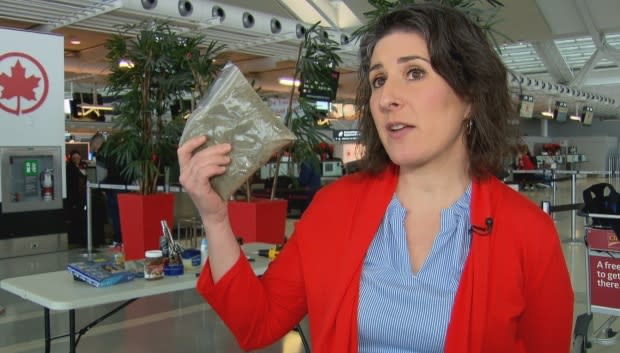Test your travel knowledge: What are you allowed to pack before getting on that flight?
You have a carton of milk in your carry-on, more than 100 millilitres, and then get to security screening: will it get tossed? Keep reading to learn the answer.
It's one of many travel rules that are important to know before you get to the airport.
It's not just milk that may stump people, but also items as wide-ranging as batteries, cannabis and cough syrup.
In advance of the busy holiday travel season, the Canadian Air Transport Security Authority (CATSA) has laid out some of the items it's confiscated recently as a reminder to travellers who don't want to lose any of their valuables.
Among the odd ones: a power drill, a wine-bottle holder made of two fake handguns and an aerosol air horn.
For that first item, the power drill, you can travel with it, said CATSA spokesperson Christine Langlois, but you'll need to take it apart first.
"Lithium batteries should go in [your] carry-on," she said. "The tool itself should go in checked [baggage]. It's really a question of preparing."

The wine bottle holder made from guns should also be checked, she explained.
"They are fake, obviously, but we don't like ammunition or gun replicas in carry on. They don't fly."
Aerosols also don't go in your carry-on.
Along with large containers of liquids and gels above the 100-ml maximum, they are an item that's most commonly confiscated, Langlois said.
As for cannabis, for domestic flights it can go in either your carry-on or checked luggage if you have up to 30 grams. Medical marijuana users are allowed to take up to 150 grams, but will have to show proof of a medical allowance.

But even though it's now legal in Canada, cannabis is always prohibited when crossing an international border, even if you're flying from Canada to another place where the drug is legal.
You can find these types of answers on CATSA's website or app by searching individual items.
If you're taking along Christmas gifts, save the wrapping for your destination: "As much as we like unwrapping gifts, we'd much prefer not to unwrap yours," said Langlois
Some items aren't allowed in a carry-on or in checked luggage. They include things like a fuel camping stove or other flammable liquids.

If you do get one of those unwanted notes in your luggage from CATSA stating that they've seized an item, don't contact the safety agency to try to retrieve it. It's the airline that takes control of confiscated objects, and you should get in touch with them, instead.
Langlois explained that CATSA has an airline representative look at the item before the decision is made whether to seize it.
WestJet said it would not make anyone available for an interview for this story, but directed CBC News to its website, which includes a search tool for item categories.
Air Canada did not respond to CBC's interview request, but Its website also includes a list of items that can reach 35,000 feet as well as those that must remain on the ground.
If you're unsure of whether you can fly with an item and you can't find it on CATSA's app, Langlois said you can send CATSA a picture and description and they'll try to figure it out, though you need to leave time, as they're only available during office hours.
"In some cases it requires research, if something is really new. We take the time to research and make a decision."
Can you ever take more than 100 ml of liquid in your carry-on?
As for that large container of milk: go ahead and pack it in your carry-on if you're travelling with a child two years old or younger. Otherwise, stick to 100 ml or less in a small bottle.
It's one of the few exemptions for taking liquid measuring more than 100 ml. Another one is any liquid medicines, such as cough syrup.


